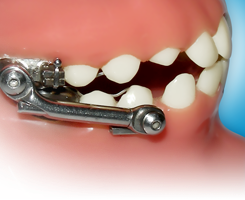Appliances

TADs
TADs are miniscrew anchors which are inserted into specific places in the mouth to be used as a fixed point from which teeth can move. Before TADs, orthodontists who wanted to move some teeth while keeping others still, or to achieve orthodontic movement in a mouth with missing teeth, had to rely on headgear for their fixed point. But TADs now provide an option for that fixed point that is smaller, more discrete, more efficient and requires significantly less work for the patient.
Forsus
The Forsus appliance is used in order to help move the upper molars back while moving the lower arch forward. Composed of a spring coil rod, the appliance is used while a patient is currently wearing braces. It runs from the upper first molar band down to the lower archwire.
You may notice some discomfort initially, so we recommend a soft food diet for the first few days after the appliance is placed. Regular anti-inflammatory medication may help with any pain, if needed. It is important to keep the appliance clean; you may do this by carefully brushing the coil and other metal pieces of the appliance. Also, we recommend that patients not open their mouths very wide, as the appliance may come apart.
If your Forsus appliance breaks, please contact our office immediately to schedule a repair appointment.
MARA
The Mandibular Anterior Repositioning Appliance (MARA) is suitable for treating class II malocclusions, which are characterized by protrusion of the upper front teeth or a lower jaw and or teeth that are positioned back in regard to the upper jaw and or teeth. Using MARA, class II malocclusions are treated more effectively. The MARA is reliable and reduces treatment time.
Generally, the appliance is secured to the patient’s first molars via stainless steel crowns, which are easy to fit and retain more, compared to bands. The appliance features no removable parts, which means patient compliance is not an issue. Also, the orthodontist can more accurately predict the length of treatment.
The upper “elbows” can be removed; which facilitates comfort and advanced adjustments. The appliance can be advanced on one side or both sides.
Sore spots are minimal. Initially, it may feel strange to hold your jaw forward while eating, but within two weeks, chewing will become more natural. We recommend you eat soft foods initially. Do not chew on the elbows. Avoiding candy, hard foods, etc. throughout treatment will help prevent breakage of the appliance.
MARA is generally worn between 15 to 18 months. Your improvements will be noticed immediately!
Herbst
One of the most common problems orthodontists treat is the discrepancy that occurs when the upper teeth protrude beyond the lower. Ordinarily, when we see a patient with the upper teeth protruding, we tend to think that the upper jaw and teeth are too far forward; but, more often than not, this condition is due to a small lower jaw that is further back than it should be. With these patients, we would like to encourage the lower jaw to catch up in growth, and braces like the Herbst appliance help this happen.
Even though the Herbst appliance prevents the lower jaw from moving backward, opening and closing movement still occur easily, and patients do not have any problems learning to chew their food with their lower jaw in this new position.
As with all kinds of braces, patients with Herbst appliances need to be careful about what they eat. For instance, cold foods such as ice slushes, Popsicles and ice will freeze the cement and make the brace loosen. Sticky foods such as caramels, bubble gum and candy suckers will pull the brace away from the teeth. Hard foods like crisp vegetables and hard candies will bend and loosen the Herbst appliance, too. So stay away from these foods during your orthodontic treatment.
Your Herbst appliance will be checked and adjusted at your appointments. If, sometimes between appointments, you develop some sore areas on the inside of your cheeks, please do not try to adjust the appliance yourself. Call for an appointment so that the necessary adjustments can be made.
Wearing a Herbst Appliance
At first, your mouth will feel unusually full and speaking will be awkward. But if you practice reading aloud, your ordinary speech will return quickly. You may also notice more saliva than normal, but this will decrease as you become accustomed to the appliance.